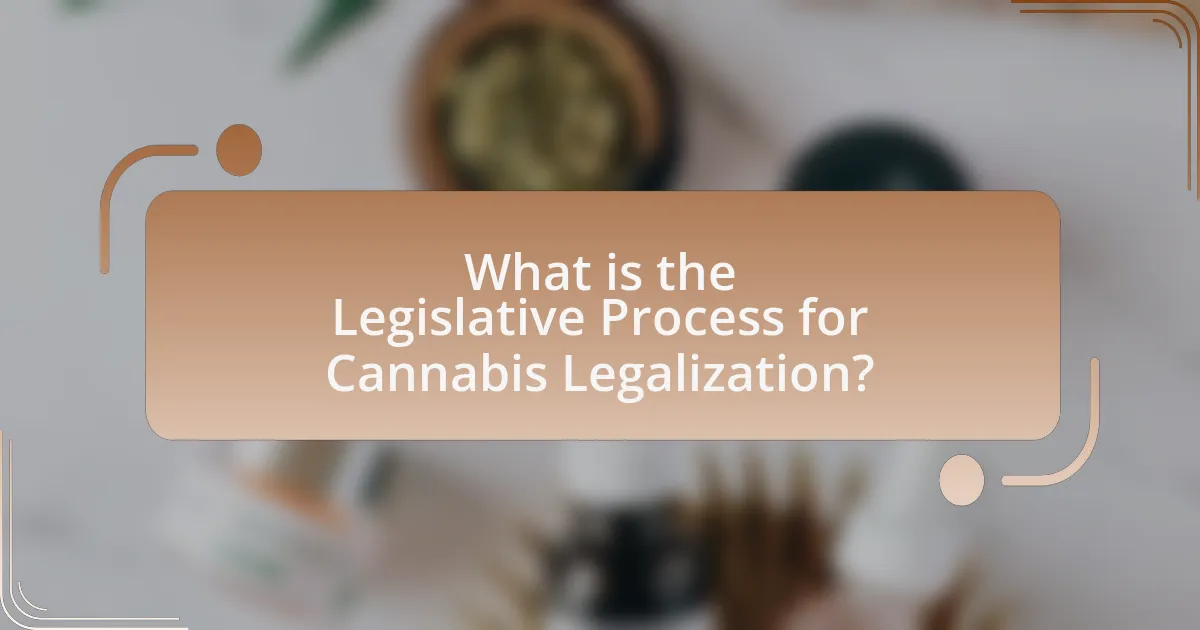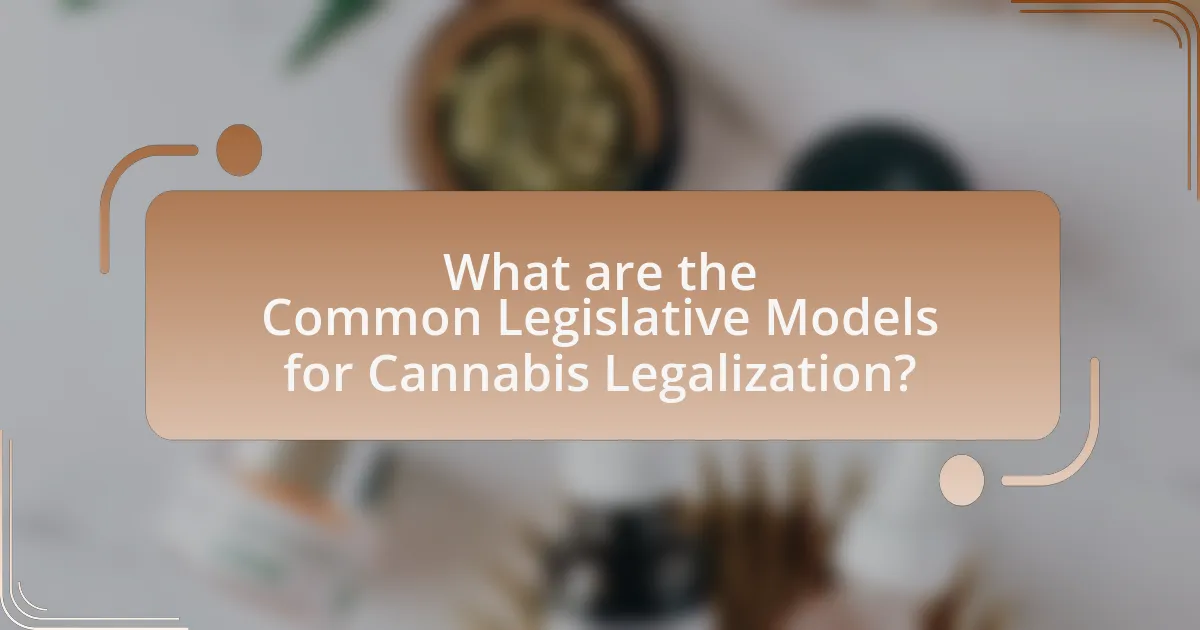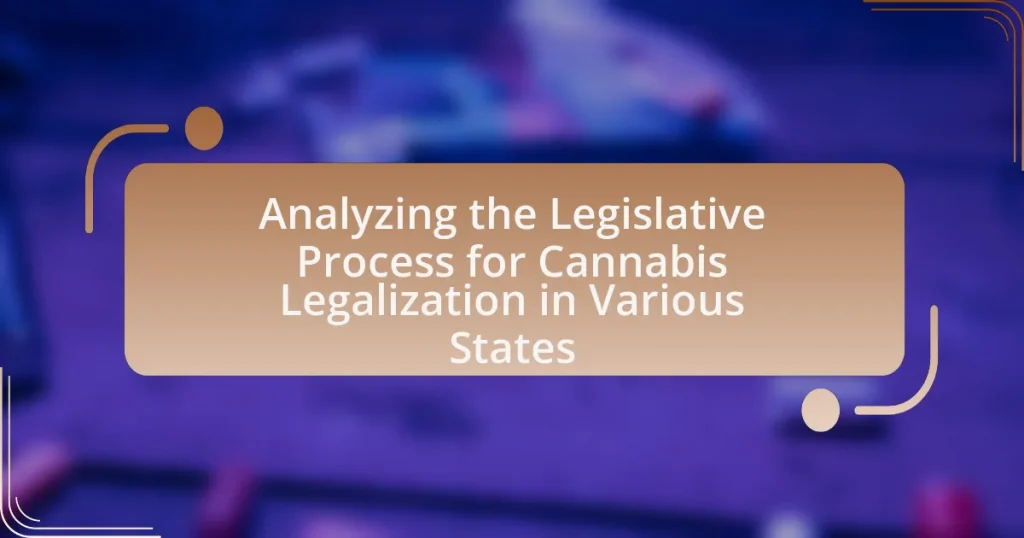The article analyzes the legislative process for cannabis legalization across various states, detailing the key steps involved, including bill introduction, committee review, floor debate, voting, and gubernatorial approval. It highlights how the process varies by state, influenced by factors such as legislative structure, public opinion, and political party dynamics. Additionally, the article discusses the impact of state constitutions, social equity issues, and regulatory frameworks on legalization efforts, while addressing challenges and controversies that arise during the legislative process. Key components of successful cannabis legislation, including stakeholder engagement and lessons learned from states with successful legalization, are also examined.

What is the Legislative Process for Cannabis Legalization?
The legislative process for cannabis legalization typically involves several key steps: introduction of a bill, committee review, floor debate, voting, and potential gubernatorial approval. Initially, a legislator introduces a bill proposing the legalization of cannabis, which is then assigned to a committee for detailed examination. The committee may hold hearings, gather public input, and make amendments before voting on whether to advance the bill to the full legislative body. If approved, the bill is debated on the floor, where further amendments can be made before a final vote occurs. If the bill passes both chambers, it is sent to the governor, who can sign it into law, veto it, or allow it to become law without a signature. This process has been observed in states like Colorado and California, where comprehensive legislative frameworks were established to regulate cannabis use and sales.
How does the legislative process vary across different states?
The legislative process varies across different states primarily in terms of the structure, procedures, and requirements for passing laws. For instance, some states have a bicameral legislature, like California and Texas, which requires bills to pass through two chambers, while others, like Nebraska, have a unicameral system. Additionally, the timeline for introducing, debating, and voting on legislation can differ significantly; states like New York have a more extended session period compared to states with shorter sessions, such as New Hampshire. Furthermore, the role of the governor in the legislative process varies; some states allow governors to veto bills, while others have limited or no veto power. These differences impact how cannabis legalization is approached, with states like Colorado implementing a more streamlined process compared to states with more complex legislative hurdles, such as New Jersey, which faced multiple revisions and public referendums before legalization.
What are the key stages in the legislative process for cannabis legalization?
The key stages in the legislative process for cannabis legalization typically include introduction, committee review, floor debate, voting, and gubernatorial approval. Initially, a bill is introduced in either the state House or Senate, where it is assigned to a committee for detailed examination. The committee reviews the bill, holds hearings, and may amend it before voting on whether to advance it. If approved, the bill moves to the floor of the legislative chamber for debate and further amendments, followed by a vote. If it passes, the bill is sent to the other chamber for a similar process. Finally, if both chambers approve the bill, it is sent to the governor, who can sign it into law, veto it, or allow it to become law without a signature. This process has been observed in various states, such as California and Colorado, where cannabis legalization has successfully progressed through these stages.
How do state constitutions influence the legislative process?
State constitutions significantly influence the legislative process by establishing the framework within which laws are created, amended, and enacted. Each state constitution outlines the powers and limitations of the legislative body, including the procedures for introducing bills, voting requirements, and the process for overriding gubernatorial vetoes. For instance, many state constitutions require a supermajority vote for certain types of legislation, which can impact the passage of laws, including those related to cannabis legalization. Additionally, state constitutions may include provisions for ballot initiatives and referendums, allowing citizens to directly influence legislation, as seen in states like California and Colorado where voters have approved cannabis legalization measures through this process.
What factors contribute to the success of cannabis legalization efforts?
Public support is a critical factor contributing to the success of cannabis legalization efforts. High levels of public approval can influence lawmakers to support legalization initiatives, as seen in states like Colorado and California, where voter referendums passed with significant margins. Additionally, effective advocacy campaigns that educate the public on the benefits of legalization, such as economic growth and criminal justice reform, further bolster support. Research indicates that states with organized grassroots movements and strong coalitions of stakeholders, including medical professionals and business leaders, are more likely to achieve successful legalization outcomes. For instance, the 2016 California Proposition 64 campaign highlighted the importance of diverse coalitions in mobilizing voters, leading to its passage with over 57% approval.
How do public opinion and advocacy groups impact legislation?
Public opinion and advocacy groups significantly influence legislation by shaping lawmakers’ perceptions and priorities. Advocacy groups, such as those supporting cannabis legalization, mobilize public sentiment through campaigns, lobbying, and grassroots efforts, which can lead to increased awareness and support among legislators. For instance, in states like Colorado and California, organized advocacy efforts and favorable public opinion polls contributed to the successful passage of cannabis legalization measures. Research indicates that when a majority of constituents express support for a policy, legislators are more likely to act in accordance with that sentiment, as seen in the 2012 Colorado vote where 55% of voters approved recreational cannabis use.
What role do political parties play in the legalization process?
Political parties significantly influence the legalization process by shaping legislative agendas and mobilizing public support. They often determine which legalization proposals are introduced, debated, and voted on within legislative bodies. For instance, in states like California and Colorado, Democratic parties have generally been more supportive of cannabis legalization, leading to successful legislative outcomes. Conversely, Republican parties in some states have opposed such measures, impacting the overall progress of legalization efforts. This dynamic illustrates how party ideologies and platforms directly affect the likelihood of cannabis legalization through their control over legislative priorities and voter engagement strategies.

What are the Common Legislative Models for Cannabis Legalization?
The common legislative models for cannabis legalization include legalization through ballot initiatives, legislative bills, and regulatory frameworks. Ballot initiatives allow citizens to propose and vote on legalization measures directly, as seen in states like California and Colorado. Legislative bills involve state legislatures drafting and voting on cannabis laws, which has occurred in states such as Illinois and New York. Regulatory frameworks establish guidelines for the cultivation, distribution, and sale of cannabis, ensuring compliance with state laws and public safety, as implemented in various states post-legalization. These models reflect diverse approaches to cannabis policy across the United States.
What types of legalization models are implemented in various states?
Various states implement three primary models of cannabis legalization: full legalization, medical legalization, and decriminalization. Full legalization allows for the recreational use of cannabis by adults, as seen in states like Colorado and California, where regulations govern sales and usage. Medical legalization permits cannabis use for specific medical conditions, with states like Florida and Pennsylvania establishing programs for patients with qualifying ailments. Decriminalization reduces or eliminates criminal penalties for possession of small amounts of cannabis, as practiced in states like Oregon and Massachusetts, where possession is treated more like a civil infraction than a criminal offense. These models reflect differing approaches to cannabis regulation and public health considerations across the United States.
How do medical and recreational cannabis laws differ in their legislative approach?
Medical and recreational cannabis laws differ primarily in their legislative approach by focusing on distinct purposes and regulatory frameworks. Medical cannabis laws are typically designed to provide access to cannabis for patients with qualifying medical conditions, often requiring a prescription from a licensed healthcare provider and establishing a system for patient registration and caregiver involvement. In contrast, recreational cannabis laws aim to regulate the use of cannabis for personal enjoyment by adults, emphasizing taxation, age restrictions, and commercial sales without the need for a medical prescription.
For example, states like California have implemented a dual system where medical cannabis is regulated under a separate framework that includes patient identification cards, while recreational use is governed by a different set of regulations that focus on retail sales and taxation. This distinction reflects the varying societal perceptions and legal considerations surrounding medical versus recreational use, influencing how each type of law is crafted and enforced.
What are the implications of decriminalization versus full legalization?
Decriminalization reduces or eliminates criminal penalties for cannabis possession, while full legalization allows for regulated production, distribution, and sale. The implications of decriminalization often include a decrease in arrests and a reduction in the burden on the criminal justice system, as evidenced by studies showing significant drops in cannabis-related arrests in states that have decriminalized. In contrast, full legalization can generate tax revenue, create jobs, and ensure product safety through regulation, as seen in states like Colorado, which reported over $1 billion in cannabis tax revenue since legalization in 2014. Thus, while decriminalization focuses on reducing legal penalties, full legalization encompasses a broader economic and regulatory framework.
How do states address regulatory frameworks in cannabis legislation?
States address regulatory frameworks in cannabis legislation by establishing comprehensive laws that govern the cultivation, distribution, and consumption of cannabis. These frameworks typically include licensing requirements for growers and retailers, taxation structures, and regulations on product safety and labeling. For instance, California’s Proposition 64 created a regulatory system that includes a Bureau of Cannabis Control to oversee the industry, ensuring compliance with state laws. Additionally, states often incorporate public health and safety measures, such as age restrictions and advertising limitations, to mitigate risks associated with cannabis use. This structured approach allows states to balance economic opportunities with public health concerns, reflecting a growing trend towards legalization across the United States.
What are the key components of regulatory frameworks for cannabis?
The key components of regulatory frameworks for cannabis include licensing, taxation, product safety, and public health measures. Licensing establishes the legal parameters for cultivation, distribution, and sale, ensuring that only authorized entities operate within the market. Taxation generates revenue for state programs and regulates pricing, while product safety standards ensure that cannabis products are tested for contaminants and accurately labeled. Public health measures address issues such as advertising restrictions and age limits to protect consumers. These components are essential for creating a structured and safe cannabis market, as evidenced by various state laws that have successfully implemented these elements to regulate cannabis effectively.
How do regulations affect the cannabis market and public safety?
Regulations significantly shape the cannabis market and public safety by establishing legal frameworks that govern production, distribution, and consumption. These regulations ensure product quality and safety standards, which can reduce health risks associated with cannabis use. For instance, states like Colorado and California have implemented strict testing requirements for cannabis products, leading to safer consumer experiences and minimizing the risk of contamination or adulteration. Furthermore, regulations can help mitigate illegal market activities by providing a legal avenue for consumers, thereby enhancing public safety through controlled access and reducing crime associated with unregulated sales. According to a report by the Colorado Department of Revenue, the regulated cannabis market has generated over $1 billion in tax revenue since legalization, which can be allocated to public safety initiatives, further reinforcing the positive impact of regulations on community safety.

What Challenges and Controversies Arise During the Legislative Process?
Challenges and controversies during the legislative process for cannabis legalization include political opposition, public opinion disparities, and regulatory complexities. Political opposition often stems from differing ideological beliefs about drug policy, with some lawmakers advocating for prohibition while others support legalization. Public opinion can vary significantly across demographics, leading to contentious debates and influencing legislative outcomes. Regulatory complexities arise from the need to establish frameworks for taxation, distribution, and public health, which can create friction among stakeholders. For instance, in states like California, the implementation of cannabis laws faced hurdles due to local government resistance and conflicting federal regulations, illustrating the multifaceted challenges inherent in the legislative process.
What are the common legal and political challenges faced in cannabis legalization?
Common legal and political challenges faced in cannabis legalization include conflicting state and federal laws, regulatory framework development, and public opinion shifts. Conflicting laws arise because cannabis remains classified as a Schedule I substance under the Controlled Substances Act, creating legal risks for states that choose to legalize it. The development of a comprehensive regulatory framework is essential for ensuring safety and compliance, yet it often faces opposition from various interest groups. Additionally, public opinion can fluctuate, impacting political support for legalization efforts, as seen in states where voter sentiment has shifted against previously supported measures. These challenges complicate the legislative process and hinder the advancement of cannabis legalization across various states.
How do federal laws conflict with state legalization efforts?
Federal laws conflict with state legalization efforts primarily because cannabis remains classified as a Schedule I substance under the Controlled Substances Act, making its production, distribution, and possession illegal at the federal level. This federal prohibition creates a legal tension where states that have legalized cannabis for medical or recreational use face potential federal enforcement actions, despite their state laws permitting such activities. For instance, the Cole Memo, issued in 2013, provided guidance to federal prosecutors to deprioritize enforcement against state-legal cannabis operations, but it was rescinded in 2018, reinstating the risk of federal intervention. This inconsistency leads to uncertainty for businesses and individuals operating in states with legalized cannabis, as they may be subject to federal prosecution despite compliance with state laws.
What are the concerns regarding public health and safety?
Concerns regarding public health and safety in the context of cannabis legalization include increased substance use, impaired driving, and potential health risks associated with cannabis consumption. Research indicates that states with legalized cannabis have seen a rise in emergency room visits related to cannabis use, highlighting the need for public health education and safety measures. Additionally, studies show that legalization can lead to higher rates of cannabis use among adolescents, raising concerns about long-term developmental effects. Furthermore, impaired driving incidents have been reported to increase in states where cannabis is legal, posing risks to road safety. These factors underscore the importance of addressing public health and safety in legislative discussions surrounding cannabis legalization.
How do social equity and justice issues influence cannabis legislation?
Social equity and justice issues significantly influence cannabis legislation by shaping policies aimed at addressing the historical injustices of drug prohibition. Legislators often incorporate social equity provisions to rectify the disproportionate impact of cannabis criminalization on marginalized communities, particularly communities of color. For instance, states like Illinois and California have implemented social equity programs that prioritize licensing for individuals from areas disproportionately affected by past cannabis laws, reflecting a commitment to restorative justice. Additionally, research from the Drug Policy Alliance highlights that equitable access to the cannabis industry can help mitigate economic disparities, further reinforcing the importance of social equity in legislative frameworks.
What measures are being taken to address past injustices in cannabis laws?
Measures being taken to address past injustices in cannabis laws include expungement of criminal records for individuals previously convicted of cannabis-related offenses. Many states, such as California and Illinois, have enacted legislation that allows for the automatic expungement of records or provides a streamlined process for individuals to have their convictions cleared. For example, California’s Proposition 64, passed in 2016, enables individuals with prior cannabis convictions to petition for expungement, thereby reducing barriers to employment and housing. Additionally, some states are implementing social equity programs aimed at providing support and resources to communities disproportionately affected by past cannabis enforcement, including access to licenses for cannabis businesses and funding for education and job training.
How do equity programs impact the cannabis industry?
Equity programs significantly impact the cannabis industry by promoting diversity and inclusion among business owners. These programs aim to rectify historical injustices faced by marginalized communities, particularly those disproportionately affected by cannabis prohibition. For instance, states like California and Illinois have implemented equity programs that provide financial assistance, training, and licensing opportunities to individuals from these communities. According to a report by the California Bureau of Cannabis Control, equity applicants in California have received over $10 million in grants and loans, facilitating their entry into the cannabis market. This not only fosters economic growth within these communities but also enhances the overall legitimacy and social responsibility of the cannabis industry.
What best practices can states adopt for successful cannabis legalization?
States can adopt comprehensive regulatory frameworks as a best practice for successful cannabis legalization. This includes establishing clear guidelines for cultivation, distribution, and sales, which helps ensure product safety and quality. For instance, Colorado’s regulatory model has been cited for its thorough approach, including strict testing requirements and licensing processes that have contributed to a robust legal market. Additionally, states should prioritize public education campaigns to inform citizens about responsible use and the legal framework, as seen in California’s efforts to address misconceptions about cannabis. Implementing equitable access measures for communities disproportionately affected by past cannabis prohibition is also crucial, as demonstrated by Illinois’ social equity programs that aim to rectify historical injustices. These practices collectively enhance the effectiveness and sustainability of cannabis legalization efforts.
How can stakeholder engagement improve the legislative process?
Stakeholder engagement can improve the legislative process by fostering collaboration and ensuring diverse perspectives are considered. Engaging stakeholders, such as community members, advocacy groups, and industry experts, leads to more informed decision-making and enhances the legitimacy of the legislative outcomes. For instance, in the context of cannabis legalization, states that actively involved stakeholders in discussions, like California and Colorado, experienced smoother implementation and greater public support, as evidenced by the successful passage of legislation that reflected the needs and concerns of various groups. This collaborative approach not only builds trust but also helps identify potential issues early, ultimately leading to more effective and sustainable policies.
What lessons have been learned from states that have successfully legalized cannabis?
States that have successfully legalized cannabis have learned several key lessons, primarily emphasizing the importance of comprehensive regulatory frameworks. Effective regulation includes clear guidelines for cultivation, distribution, and sales, which helps ensure product safety and quality. For instance, Colorado’s legalization in 2012 demonstrated that establishing a robust taxation system can generate significant revenue, with over $1 billion in tax revenue reported by 2020. Additionally, states like California have highlighted the necessity of addressing social equity, as their legalization efforts included provisions to support communities disproportionately affected by past cannabis prohibition. Furthermore, public health campaigns in states such as Oregon have shown that education on responsible use can mitigate potential negative impacts. These lessons underscore the need for thoughtful legislation that balances economic benefits, public health, and social justice.


